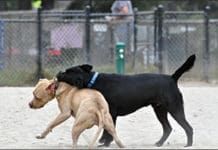Rolled-Up Welcome Mat?
No good deed goes unpunished. That’s what Pam Rowley of Upper Brookville, New York, discovered last November, when the hospital administrator who always greeted her and 8-year-old Vizsla Gunner at the start of their monthly therapy-dog visits quietly took her aside to deliver some bad news.
Letters and Corrections – April 2013
I am writing to express my concern at seeing the photograph on the cover of the April 2013 Whole Dog Journal that depicts a man running with a dog who is wearing a restrictive harness. As a specialist in canine sports medicine, I have significant concerns about the use of harnesses that wrap around the front of dog’s forelegs, particularly in circumstances like this, where a dog is exercising using a gait that requires forelimb…
When Dog Collars Become Deadly
I was pretty traumatized recently by a phenomenon I had heard about many times but had never before seen: the intense, chaotic, life-or-death struggle that ensues when one dog gets his jaw stuck in another dog's collar. These dogs survived the experience. But since I've been telling my friends about my experience (with all the fervor of the recently converted), I've heard about a number of dogs whose jaws were broken in similar situations
Hormone-Altering Chemicals A Common Hazard In Dog Toys
Researchers at Texas Tech University found that many popular bumpers" (items used for training retrievers) and other plastic toys exude BPA and phthalates when subjected to conditions that simulate chewing by a dog."
Crate Thanks
An after-dinner family ritual, when I was a kid, was for each person seated at the table to share what they were most grateful for since last Thanksgiving. Those dinners don’t happen any more, but each year I ask myself that old question. Sometimes the answer is cause for mental debate, but this year, there was no doubt at all. One thing leaps instantly to mind: the fact that my dogs are both safe, that neither was injured when a speeding bicyclist T-boned my new Subaru in September.
Senior Supplements for Canine Cognitive Dysfunction
Canine cognitive dysfunction (CCD), also called cognitive dysfunction syndrome, is comparable to Alzheimer’s disease in humans. Dogs with CCD may show signs such as confusion, disorientation, anxiety, irritability, apathy, reduced interaction, house soiling, forgetfulness, and aimless wandering or pacing, especially at night. CCD can rob a dog of quality of life, and make living with an old dog difficult.
Plant Oils for Dogs
There are many different types of plant oils that people use to supplement their dogs’ diets, including oils from flaxseed, olives, coconut, vegetables, hempseed, and more. Some of these oils can provide benefits, but others are not helpful and may even contribute to inflammation.
Canned Food Review; Mixed-Breeds vs. Pure; Another Harness
Just read your “Canned Food Review” (WDJ October 2012) with interest and definitely learned some stuff. I’d like to get on your radar for next time a fairly-new-to-the-market canned food that was recommended to us by our locally owned pet food store, where the owners do a lot of research on pet foods. You won’t find Pedigree or Science Diet there.
Control Harness Fitting and Use Tips
Here are some trade secrets to getting your control harness to work better for you and your dog. With several of the simpler styles (SENSE-ation, SENSE-ible, Easy Walk) if you can’t get the harness to fit quite right, try putting it on upside down. (Doesn’t work with any of the “two-points-of-contact” harnesses.) If the front strap still slips down, clip your leash to the front-clip ring and the collar ring. This may diminish the effectiveness of the harness a little, but it will keep the front strap up and in place.
Proper Use of No-Pull Harnesses
Some trainers scoff at the use of tools such as control harnesses, claiming that you are simply managing" a problem behavior rather than training the dog. A well-designed control harness
No-Pull Dog Harness Product Review
Once upon a time, a harness was the last thing you wanted to use for a dog who pulled, because they were designed to make pulling comfortable. By distributing pressure evenly across the chest they removed pressure from the throat, where damage could be done to a dog's trachea sometimes even to the point of tracheal collapse. Harnesses are better for the dog from a health perspective, but from a training viewpoint, a standard harness actually encourages pulling. There's a reason sled dogs wear harnesses! Head halters were introduced in the late 1990s as a gentle control tool. While they did, indeed, work well to control a dog's head (and where the head goes, the body follows), some trainers noticed that a significant number of dogs found head halters to be fairly aversive, requiring, in many cases, extensive conditioning to convince the dog to accept them.
Older Dogs and Surgery
Some are reluctant to perform surgery on old dogs because of anesthesia risks or complications, but these risks are minimal in the case of most lipomas. Modern anesthesia protocols are far safer than they used to be, and complications are generally minor, usually limited to superficial infection or delayed healing. There is no reason not to remove lipomas from older dogs when they interfere with their quality of life.

















